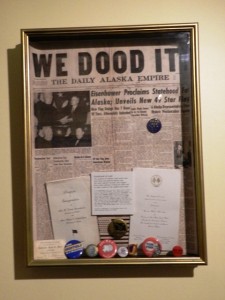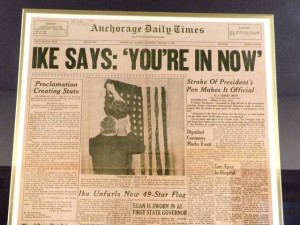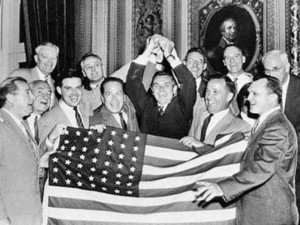» posted on Thursday, July 26th, 2012 by Linda Lou Burton
Ike and the 49th Star
Linda Burton posting from Juneau, Alaska – In Juneau, it was 9:02 AM. Back east in Washington, DC, it was just past the noon hour as President Dwight D Eisenhower inscribed his name to the document of proclamation that made Alaska the 49th state. Then he signed an Executive order setting a new design of 49 stars for the official flag of the United States. The date was January 3, 1959. The new design had seven staggered rows of stars, with seven stars in each row, and the traditional thirteen stripes. It had been chosen by a four-man selection commission and formally approved by the President but didn’t become official until July 4, 1959. The New York Times reported: President Eisenhower told one of the guests at the ceremony today that it was not the design he had preferred, “but I was overruled by all my advisers.” His choice was nine rows of stars, alternating five and six stars to a row.
 Grandson Sam and I made a special trip back to the state capitol today to get more pictures of the flag and the framed newspaper pages that adorn the walls with the story of that momentous day. We Dood It! reads one headline. We’re In! says another. It was a hard-fought battle, and it took a lot of procedural steps to get there. Sam and I clicked our cameras, making note of what happened that day. Here’s what we learned.
Grandson Sam and I made a special trip back to the state capitol today to get more pictures of the flag and the framed newspaper pages that adorn the walls with the story of that momentous day. We Dood It! reads one headline. We’re In! says another. It was a hard-fought battle, and it took a lot of procedural steps to get there. Sam and I clicked our cameras, making note of what happened that day. Here’s what we learned.
Speaker Sam Rayburn and Vice President Richard Nixon were seated beside the President for the ceremony. Behind them stood Alaska Senators-elect E L Bartlett and Ernest Gruening, Representative-elect Ralph Rivers, Acting Territorial Governor Waino Hendrickson, former Territorial Governor Mike Stepovich, Chairman of the Alaska Statehood Committee Robert Atwood, and Secretary of the Interior Fred Seaton.
 After signing, the President spoke a brief informal greeting to the people of Alaska and their delegation. Then Lt Col James Cook Jr, chief of the heraldic branch of the Quartermaster Corps, unfurled the new banner, which the President held. The President, one of the few persons who had seen the new design in advance, took another look after the unfurling, then chatted a moment with the guests, stating he felt “very highly privileged and honored” to welcome the 49th state. He noted that there had been no such ceremony as this in almost half a century. (President William Howard Taft signed the 48th statehood proclamation for Arizona on February 14, 1912.)
After signing, the President spoke a brief informal greeting to the people of Alaska and their delegation. Then Lt Col James Cook Jr, chief of the heraldic branch of the Quartermaster Corps, unfurled the new banner, which the President held. The President, one of the few persons who had seen the new design in advance, took another look after the unfurling, then chatted a moment with the guests, stating he felt “very highly privileged and honored” to welcome the 49th state. He noted that there had been no such ceremony as this in almost half a century. (President William Howard Taft signed the 48th statehood proclamation for Arizona on February 14, 1912.)
 Meanwhile in Juneau, Governor-elect William Egan waited outside the state capitol for word. At 9:18 AM, with media and Alaska representatives looking on, he walked into the Governor’s Office with his wife Neva and son Dennis and took the oath of office as the state’s first governor. As word spread throughout the city, a crowd began to assemble at the 20th Century Theatre downtown and by 11 AM a thousand people were waiting as the new governor made his first public appearance. Egan proclaimed that Alaska’s “apprenticeship” was over and celebrated the state as the newest member of the union nearly 100 years after the United States had purchased it from Russia.
Meanwhile in Juneau, Governor-elect William Egan waited outside the state capitol for word. At 9:18 AM, with media and Alaska representatives looking on, he walked into the Governor’s Office with his wife Neva and son Dennis and took the oath of office as the state’s first governor. As word spread throughout the city, a crowd began to assemble at the 20th Century Theatre downtown and by 11 AM a thousand people were waiting as the new governor made his first public appearance. Egan proclaimed that Alaska’s “apprenticeship” was over and celebrated the state as the newest member of the union nearly 100 years after the United States had purchased it from Russia.
“Russia, that’s right,” I said to Sam. “Alaska was purchased from Russia.” That happened on March 30, 1867 when Secretary of State William Seward paid $7.2 million for all this land; it came out to about two cents per acre and it wasn’t a very popular decision at the time. People called it “Seward’s Folly” and didn’t see much use for such an isolated place of snow and ice. “They’re not complaining now!” I said to Sam. Alaska became a territory on May 11, 1912, the 49th state on January 3, 1959, and has since produced billions of dollars in resources such as oil, ores, salmon, and timber.
 Sam and I got more pictures of the articles about the ceremonies and the 49-star flag before heading back to our room for some lunch. “I really like that 49-star flag,” Sam said as he finished up last night’s pizza. “But we didn’t have 49 stars for very long, did we?” I checked the internet for exact dates. “Just a year,” I confirmed. “From July 4, 1959 until July 4, 1960. Hawaii was admitted as the 50th state August 21, 1959, but the 50-star flag didn’t become official until July 4 of the next year.”
Sam and I got more pictures of the articles about the ceremonies and the 49-star flag before heading back to our room for some lunch. “I really like that 49-star flag,” Sam said as he finished up last night’s pizza. “But we didn’t have 49 stars for very long, did we?” I checked the internet for exact dates. “Just a year,” I confirmed. “From July 4, 1959 until July 4, 1960. Hawaii was admitted as the 50th state August 21, 1959, but the 50-star flag didn’t become official until July 4 of the next year.”
An interesting thought came to mind as we looked at a picture of the 50-star flag. “President Eisenhower finally got his wish,” I laughed. “The 50-star flag has nine rows of stars, just like he suggested.”
Note: President Eisenhower preferred nine rows for the 49-star flag, with alternating rows of five and six stars; the panel chose seven rows of seven stars. The 50-star flag has nine rows, with alternating rows of six and five stars; the official flag of the United States since July 4, 1960. Although the seven-row design may not have been his choice, President Eisenhower claims the fame of being the only President to serve under the 49-star flag.


